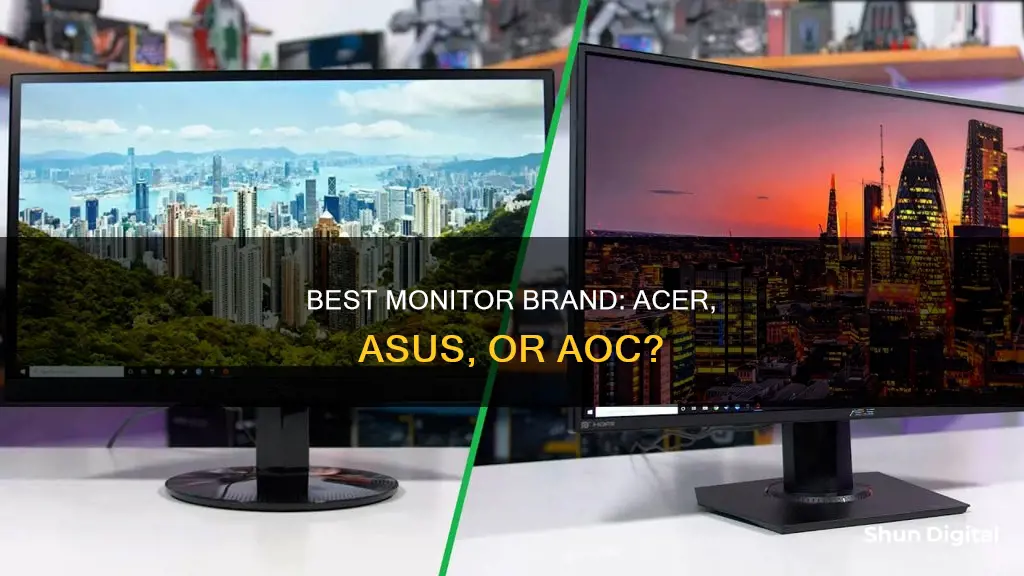
When it comes to monitors, there are several factors to consider when choosing between brands like Acer, ASUS, and AOC. All three brands offer a range of options catering to different needs, whether it's for gaming, professional work, or casual browsing. In terms of design, ASUS and Acer monitors are known for their ergonomic adjustments, offering tilt, swivel, and height adjustment options for user comfort. ASUS stands and bezels tend to have a higher-quality look and feel, while Acer's Predator line stands out for its sturdy construction. AOC monitors, on the other hand, are praised for their sleek and slim profiles, seamlessly blending into any workspace.
When it comes to display quality, all three brands have their strengths. ASUS and Acer often share similar display panels, resulting in comparable image quality. ASUS excels in its user interface, with well-laid-out on-screen displays and additional software for quick adjustments. Acer, on the other hand, offers a broader spectrum of monitors, including premium models that cater to professionals with their emphasis on colour accuracy and sharper imagery. AOC monitors are known for their high refresh rates, ideal for smooth gameplay, and their colour accuracy, making them a top pick for design tasks.
Price-wise, Acer is often the value winner, offering excellent price-performance options. ASUS monitors are generally more expensive but deliver on quality and design, making them a good choice if your budget allows. Ultimately, the decision between these brands depends on your specific needs, budget, and preferences. Each brand has its unique features and advantages, so it's essential to evaluate their offerings based on your priorities.
What You'll Learn

Display quality, price, and features
Display Quality
AOC monitors are known for their sleek, modern design, with slim profiles and seamless multi-monitor setups. They offer a range of resolutions, from Full HD to 4K, and are particularly appealing to gamers with their high refresh rates of up to 240Hz and rapid 1ms response time. Acer, on the other hand, is renowned for its reliable monitors, with a focus on colour accuracy and sharper imagery. Their Predator series, for example, offers up to 144Hz refresh rates, with select models providing 1ms response time. Acer also excels in ergonomic design, with tilt, swivel, and height adjustment options.
Price
When it comes to pricing, both brands offer a range of options to suit different budgets. AOC's budget-friendly models, such as the 24B1H, deliver essential features at an affordable price. Similarly, Acer's SB220Q provides quality without breaking the bank. At the higher end, AOC's U2790VQ and Acer's Predator XB273K offer premium features and advanced technology for a more immersive viewing experience.
Features
In terms of features, both AOC and Acer monitors include standard connectivity options like HDMI and DisplayPort. Acer may offer more ports, which is beneficial for multitaskers. AOC monitors stand out for their intuitive on-screen menus and responsive controls, while Acer's OSD can sometimes feel more complex. Additionally, AOC provides the Display Widget software, which allows for quick adjustments and customisation based on the app being used. Acer, meanwhile, has models with NVIDIA G-SYNC technology, ensuring a tear-free experience.
Both AOC and Acer have their strengths, offering a range of quality monitors catering to different needs. AOC excels in refresh rates and response time, making it ideal for gamers, while Acer provides reliable performance, colour accuracy, and ergonomic design. Price-wise, both brands have affordable and premium options, so it ultimately comes down to your specific requirements and preferences.
Asus vs LG: Who Makes Better Monitors?
You may want to see also

Gaming and professional use
When it comes to gaming and professional use, there are several factors to consider when choosing between Acer, ASUS, and AOC monitors. All three brands offer excellent options, but each has its own unique features and advantages.
Acer Monitors
Acer has built a reputation for providing quality displays at affordable price points, catering to both casual and hardcore gamers. They offer a wide range of features, including IPS panel technology, high refresh rates, and AMD FreeSync support. Their monitors are also console gaming-ready, with dedicated settings optimized for console gamers. In terms of pricing, Acer has options for every budget, ranging from entry-level 1080p models under $150 to premium 4K and widescreen monitors costing up to $800 or more. Acer's ConceptD line is particularly well-suited for creative professionals, offering excellent color accuracy and vibrant visuals at a more affordable price point compared to competitors.
ASUS Monitors
ASUS is known for its innovative features and high-performance gaming monitors. They offer Nvidia G-Sync support, high refresh rates, low response times, and ergonomic designs. ASUS monitors are priced at a premium, with mid-range options starting at $250 and 4K and ultra-wide models costing over $800. Their TUF Gaming monitors are specifically optimized for competitive gaming, with features like crosshair overlays and genre-specific display modes. ASUS also offers the ProArt line, which is highly regarded for its color accuracy and is tailored towards photographers, video editors, and graphic designers.
AOC Monitors
AOC is known for its user-friendly and innovative displays, often providing cost-effective options with high-performance features for gamers and casual users. AOC monitors boast high refresh rates, with some models offering up to 240Hz, ideal for smooth and seamless gameplay. Additionally, AOC guarantees a 1ms response time across many of its models, giving gamers a critical in-game advantage. AOC's displays also stand out for their aesthetic appeal, with sleek frames, slim profiles, and minimalist stands that complement any workspace.
Recommendations
Based on the information provided, here are some recommendations for gaming and professional use:
- For Gaming: If you're a hardcore gamer looking for the absolute best performance and gaming-centric features, ASUS monitors are the way to go. Their high refresh rates, low response times, and Nvidia G-Sync support offer a competitive edge. However, if you're a casual or mid-core gamer on a budget, Acer's Nitro line provides an excellent balance of quality and affordability, with high refresh rates and vibrant colors.
- For Professional Use: For creative professionals seeking color accuracy and consistency, ASUS ProArt monitors are highly recommended for their stellar color accuracy and ability to match print standards. AOC monitors are also a good choice, offering high color accuracy and vibrant displays at more affordable price points. For professionals requiring precision and accuracy, Acer's ProDesigner series ensures exact colors and unbeatable precision.
Overclocking Your ASUS Monitor to 75Hz: A Step-by-Step Guide
You may want to see also

Response time for competitive gaming
When it comes to competitive gaming, response time is crucial. A monitor with a high refresh rate and low response time will provide a smoother and more responsive gaming experience.
The Acer Predator XB271HU, the AOC AG271QG, and the ASUS ROG Swift PG279Q are all 27", 2560x1440p, IPS panel monitors with a 144Hz native/165Hz overclocked refresh rate and G-Sync modules. The response time and input lag for these monitors are some of the lowest available, making them ideal for competitive gaming. The ASUS VG278Q is another excellent option, with a 144Hz display and AMD's FreeSync adaptive sync technology. It also includes an Extreme Low Motion Blur (ELMB) mode, which can further reduce blur during fast-paced games.
The AOC 24G2 is a 24", 1080p monitor with a 144Hz refresh rate and an exceptional response time, making it another excellent budget option for competitive gaming.
While the Dell S2716DG is the cheapest option, it is a TN panel with no speakers and poor colour reproduction, which may not be ideal for competitive gaming.
Overall, if you are looking for a monitor with a fast response time for competitive gaming, the Acer, ASUS, and AOC options listed above are all excellent choices, depending on your budget and specific needs.
Monitoring Bandwidth Usage: Airport Extreme Edition
You may want to see also

User experience and interface
When it comes to user experience and interface, both AOC and Acer monitors offer on-screen display (OSD) controls. However, the two brands differ in their approach to design and ease of use. AOC monitors typically feature intuitive menus with responsive buttons or joystick controls. On the other hand, Acer's OSD may sometimes feel more complex, with more menus to navigate through. Acer's menus are gradually improving, but the information is not as well laid out as AOC's.
In terms of software solutions, both brands work well with various operating systems. AOC offers the Display Widget software, while compatibility with Windows is a common feature for both.
For users who prioritise straightforward controls and easy navigation, AOC might be the preferred choice.
Opening the Back of an Asus VX238 Monitor
You may want to see also

Customer support and warranty
When it comes to customer support and warranty, all three brands offer competitive after-sales services. Acer, ASUS, and AOC provide 3-year warranties on their monitors, covering parts and labour. This is an advantage over some other major brands like Samsung, MSI, and Viewsonic, which only offer a 1-year warranty.
In terms of customer service experience, both AOC and Acer are known for their commitment to customer satisfaction, offering multiple support channels that are easily accessible and efficient. AOC provides a straightforward support process with live chat and email options, while Acer offers phone, email, and social media support with commendable response times.
ASUS also has a good reputation for its RMA (Return Merchandise Authorization) and warranty departments. One customer reported finding them satisfactory when dealing with issues such as backlight bleed, IPS Glow, dead pixels, and cracked bezels.
When it comes to specific warranty terms, there are some differences between the brands. For example, AOC's warranty covers backlight issues, while Acer's warranty once had a poor dead pixel policy, which has since improved and is now similar to ASUS and AOC.
Overall, all three brands offer solid customer support and warranty options, but the specific needs and experiences of individual customers may lead to varying preferences.
Monitoring Your Dryer's Electricity Usage: A Step-by-Step Guide
You may want to see also
Frequently asked questions
It depends on your needs and preferences. All three brands offer a range of quality displays, with varying features and price points.
ASUS often excels in gaming performance and has better on-screen displays, software, and design. Acer is known for its value, offering price vs. performance and is a good choice if you want to upgrade your specs within a budget. AOC is also known for its cost-effective options and focuses on high-performance features for gamers and casual users.
For a budget-friendly option, consider the Acer R240HY, which offers good display quality and features for its price. If you're looking for a high-end gaming monitor, the ASUS ROG Swift PG279Q and Acer Predator XB271HU are excellent choices with high refresh rates and low input lag. For a premium experience, the AOC U2790VQ or Acer Predator XB273K offer advanced technology and spectacular viewing experiences.







